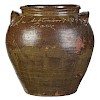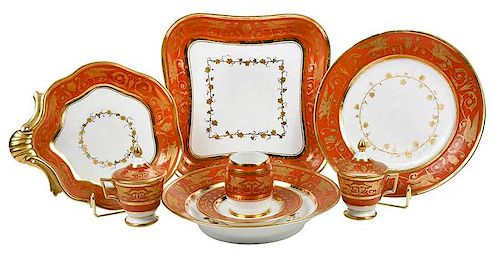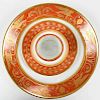Lot 963
Rare 92 Piece Dagoty Service, S M. l'Imperatrice
Estimate: $4,000 - $6,000
Unsold
Bid Increments
| Price | Bid Increment |
|---|---|
| $0 | $25 |
| $100 | $50 |
| $1,000 | $100 |
| $2,000 | $200 |
| $3,000 | $250 |
| $5,000 | $500 |
| $10,000 | $1,000 |
| $20,000 | $2,000 |
| $50,000 | $5,000 |
| $100,000 | $10,000 |
French, early 19th century, a fine porcelain partial service designed byÿPierre-Louis Dagoty (1771-1840), elegantly decorated with a frieze of burnished gilt winged lions, arabesques, masks, and antique vases, contrasting on an enamel decorated blood-orange border, reminiscent of Egyptian decoration, the center field decorated with burnished gilt designs of continuous intertwining grape vines, service comprising four covered pots de creme, two mustard pots with attached plates, 53 luncheon plates, 13 rim soup bowls, four shell form dishes, four square shape dishes, two boat shaped dishes, one deep serving bowl, two large round platters, three medium round platters, one smaller round platter, three oval platters, largest 17-1/2 x 11-1/2 in; 57 pieces stenciled in iron red "MANUFACTURE. / de S M. l'Imp‚ratrice / P.L. DAGOTY / A PARIS" to basesNote:ÿThe Dagoty Manufactory, named porcelain manufacturer to the Empress Jos‚phine, quickly became one of the most prominent and successful industries during the golden age of porcelain production in Paris. Dagoty?s designs were influenced by Neoclassical, Chinoiserie, and Egyptian motifs and were distinguished by the use of burnished gold leaf and bold colors. His fashionable wares with rich ornamentation were quintessential of the Empire, and were heavily endorsed by the patronage of Empress Jos‚phine. Lavish porcelain wares were provided to the Empress and the Royal French Court at Versailles.A gouache and pencil sketch of this porcelain service design is housed in the V&A Museum in Paris, France. Museum no. 3235:14 http://collections.vam.ac.uk/item/O250963/design-dagoty-porcelain-factory/ÿ, Provenance: Arpad Antiques, Inc. Washington, DC; Collection from an Important American Family
gilt loss to varying degrees throughout (especially to center field decorations and rims) with some areas of retouch, some enamel loss, approximately 15 pieces with small hairlines and/or minor chips to bases and rims, approximately 18 pieces with larger hairlines and/or spider cracks, three luncheon plates and one small round platter with major repairs, one pot de creme lid with repair and small chip to finial, one pot de creme lid with detached finial (but present), one pot de creme lid with possible repair (discolored surface), mustard pots lacking lids, one large round platter with many scattered hairlines, one oval platter with chip to rim and gilt retouch, scattered firing anomalies and pinholes, other surface wear and abrasions consistent with age and use
Condition
Purchaser agrees that packing and shipping is done at the purchaser’s risk and that the purchaser will pay in advance all packing expenses, materials, carrier fees and insurance charges. At our discretion, items will either be packed by an agent such as a packaging store or Brunk Auctions. Please allow two weeks for shipping after payment is received. Shipment of large items is the responsibility of the purchaser. We are happy to provide names of carriers and shippers if a purchaser so requests. Brunk Auctions will have no liability for any loss or damage to shipped items. Items purchased from our Asheville auction facility not picked up within ten business days of the auction will be assessed a storage fee of $5.00 per day, per item.



























